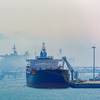UK: First Steel Cut for First Type 31 Frigate HMS Venturer
First steel was cut Thursday for the first of the UK Royal Navy’s five new Type 31 frigates, HMS Venturer.
The historic ceremony took place at Babcock's factory in Rosyth, Scotland, where the Type 31 Inspiration class ships are being constructed.
"The frigates will be at the heart of the Royal Navy’s surface fleet, deterring aggression and maintaining the security of the UK’s interests as well as providing humanitarian relief when needed. The frigates will work alongside the UK’s Allies to deliver a warship presence across the globe and enable a forward naval presence," Babcock said in a statement.
The symbolic first cut of steel for HMS Venturer comes a week after Babcock said it had secured the first export contract for its Arrowhead 140 frigate - the export variant of the UK Type 31 platform - through a design licence agreement with PT PAL Indonesia (Persero) for two frigates.  Credit: Babcock
Credit: Babcock
Babcock CEO David Lockwood said: "This is a significant moment. We are witnessing what the National Shipbuilding strategy can achieve. Working with our partners and customers, we are creating something we can all be very proud of. The T31 Class will show the adaptability and capability of a modern warship created with British ingenuity and engineering at its core. I’m looking forward to seeing these magnificent vessels emerge from our newly-named Venturer Building.”
Defense Secretary and Shipbuilding Tsar Ben Wallace said: "Today is a momentous occasion for the Type 31 program, Defense and the shipbuilding industry in Scotland. As Shipbuilding Tsar, to cut the steel for the first of five new frigates that will be constructed here on our shores in the Firth of the Forth, providing jobs and innovation to the area, is a tremendous honor."
“Equipped with the technologies at the forefront of the Royal Navy’s future vision, the entire Type 31 fleet will be fitted with a range of capabilities allowing it to undertake a variety of operations at sea.”
A direct UK workforce of around 1,250 people will be employed on the program at its peak, including 150 apprenticeships, and a further 1,250 in the supply chain.
The first ship is expected to be in the water in 2023 with all five ships delivered by 2028.











